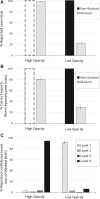Sensitivity to perception level differentiates two subnetworks within the mirror neuron system
- PMID: 28338793
- PMCID: PMC5460052
- DOI: 10.1093/scan/nsx015
Sensitivity to perception level differentiates two subnetworks within the mirror neuron system
Abstract
Mirror neurons are a subset of brain cells that discharge during action execution and passive observation of similar actions. An open question concerns the functional role of their ability to match observed and executed actions. Since understanding of goals requires conscious perception of actions, we expect that mirror neurons potentially involved in action goal coding, will be modulated by changes in action perception level. Here, we manipulated perception level of action videos depicting short hand movements and measured the corresponding fMRI BOLD responses in mirror regions. Our results show that activity levels within a network of regions, including the sensorimotor cortex, primary motor cortex, dorsal premotor cortex and posterior superior temporal sulcus, are sensitive to changes in action perception level, whereas activity levels in the inferior frontal gyrus, ventral premotor cortex, supplementary motor area and superior parietal lobule are invariant to such changes. In addition, this parcellation to two sub-networks manifest as smaller functional distances within each group of regions during task and resting state. Our results point to functional differences between regions within the mirror neurons system which may have implications with respect to their possible role in action understanding.
Keywords: action observation; conscious perception; fMRI; mirror neuron system.
© The Author (2017). Published by Oxford University Press.
Figures





References
-
- Avenanti A., Annella L., Candidi M., Urgesi C., Aglioti S.M. (2013). Compensatory plasticity in the action observation network: virtual lesions of STS enhance anticipatory simulation of seen actions. Cerebral Cortex, 23(3), 570–80. - PubMed
-
- Benjamini Y., Hochberg Y. (1995). Controlling the false discovery rate: a practical and powerful approach to multiple testing. Journal of the Royal Statistical Society. Series B (Methodological), 57(1), 289–300.
-
- Bien N., Roebroeck A., Goebel R., Sack A.T. (2009). The Brain's intention to imitate: the neurobiology of intentional versus automatic imitation. Cerebral Cortex, 19(10), 2338–51. - PubMed
-
- Bischoff M., Zentgraf K., Pilgramm S., Stark R., Krueger B., Munzert J. (2014). Anticipating action effects recruits audiovisual movement representations in the ventral premotor cortex. Brain and Cognition, 92, 39–47. - PubMed
-
- Borg I., Groenen P.J. (2005). Modern Multidimensional Scaling: Theory and Applications. Springer Science & Business Media.
MeSH terms
Substances
LinkOut - more resources
Full Text Sources
Other Literature Sources

